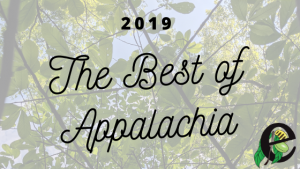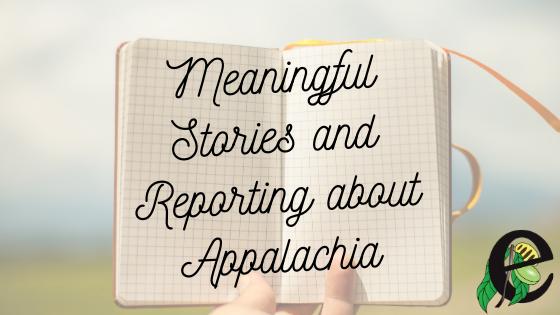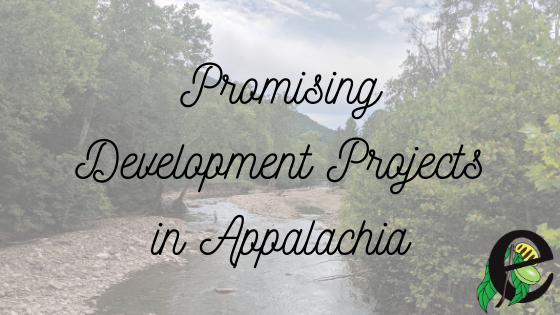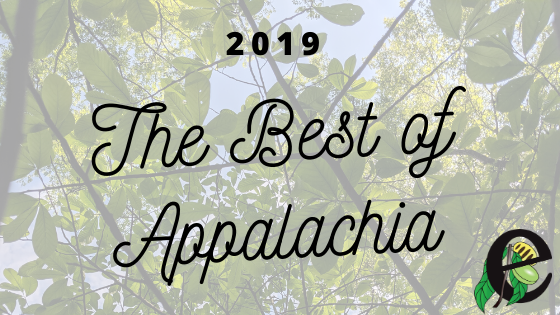
As many expatalachians readers can attest, Appalachia is a complex, messy, and beautiful region. The new year offers a time to reflect on the year gone by. By looking back at the positive events, expatalachians hopes that they can be channeled to make 2020 an even better year.

It was extremely difficult to only choose a few stories to highlight. Ultimately, these stories made the list because they amplified narratives that exposed injustice and reframed ideas about what Appalachia is.
This podcast explores the life, legacy, and influence of an Appalachian icon, Dolly Parton. The series breaks down various moments in Parton’s life, from her childhood in rural Tennessee to her time on the Porter Wagoner Show. It also evaluates the nostalgic power of Parton’s songs and her complicated role in politics. Beyond being an enjoyable listen, this series encourages listeners to consider their understanding of Parton, Appalachia, and America.
2. “They Were Promised Coding Jobs in Appalachia. Now They Say It Was a Fraud”
Economic development is a huge topic in Appalachia. As mining jobs disappear, alternatives are needed to fill the employment void. This is where the company, Minded Minds, comes in. Promising employment in the tech sector, Minded Minds vowed to train Appalachians in computer coding. The company received support from many people and even secured funding from the Appalachian Regional Commission. However, Minded Minds fell far short on their promises and left many devoted students without training or jobs. That failure was yet another broken promise Appalachians have become accustomed to expect. The situation also raises questions for how to better implement and foster success in future economic development projects.
3. “The People Left Behind in a Broadband World”
In this day and age, the internet allows individuals to complete a variety of activities from paying bills to doing homework. Although the internet is central to many common tasks, many folks in rural America and Appalachia still do not have reliable broadband, a high-speed internet connection. This photojournalism reporting project followed people in southeastern Ohio as they found resourceful ways (using local libraries and hotspots) to connect to the internet. As broadband access improves globally, the question of why Appalachia lags behind remains.
4. Good River
This is a series of stories that analyze the Ohio River watershed. This collaborative effort brought together several nonprofit news organizations that contributed stories about the environment, economy, and culture of the watershed. From an interactive history of the Cheat River to an analysis of the potential impacts of the Shell ethane cracker in Beaver County, Pennsylvania, the Good River series provided a broad and in-depth analysis of the watershed.
5. Dark Waters
Although a new release, the story told in Dark Waters is old news. The film, starring Mark Ruffalo, dramatizes a real-life legal battle between attorney Rob Billot and DuPont. The legal battle may be over, but the legacy of DuPont’s crimes–dumping “forever chemicals” such as C-8 or PFOA–lives on.
In 2016, The New York Times documented the battle, which was the basis for the film. In 2018, the documentary The Devil We Know also explored this environmental catastrophe. All of the reporting keeps the conversation about DuPont’s environmental crimes alive. It’s important to emphasize what happened because the secrecy surrounding the pollution meant that people died from illnesses related to the illegal dumping and were unaware that they were exposed to high levels of toxins. With more publicity, awareness about the negative environmental and health impacts are getting exposed.

It has been an especially exciting and genre-bending year in music. Many Appalachian artists are creating new sounds from diverse experiences and influences. From Che Apalache’s “Latingrass” to bbymutha’s bold approach to rap, Appalachians are standing out in the music scene.
Brittany Howard was already well-known as the frontwoman of the Grammy-nominated group Alabama Shakes before departing on a journey of self-exploration for her first solo album, Jaime. The name of the album is the name of Howard’s sister who shaped her as a human being before she died of cancer when they were teenagers. In reference to why she embarked on this solo, healing musical journey, Howard eloquently wrote:
“I did this so her name would no longer bring me memories of sadness and as a way to thank her for passing on to me everything she loved: music, art, creativity.”
Although named after her sister, this album is also about Howard. Her relationship with home (Athens, Georgia), family, and her identity as a queer, mixed-race woman all shape the lyrics and sound of Jaime. Howard’s impressive vocals and thoughtful lyrics make Jaime a powerful album.
2. bbymutha
Based in Chattanooga, Tennessee, rapper Brittnee Moore (“bbymutha”) has been attracting attention since 2017. With a defined fashion sense and ability to mix soundscapes, trap, and hip hop, bbymutha is expanding the boundaries of rap. The name “bbymutha” references Moore’s experience as a single mother to two sets of twins. Although being a mother is part of Moore’s identity, so is sexuality and womanhood, which are all frequent subjects in her songs. In October 2019, bbymutha performed her new single, “Heavy Metal,” for COLORS. In the video, she commands the listener’s attention, confidently rapping in a pink crochet two-piece outfit.
3. Faye Webster
Atlanta Millionaires Club is the third release for 21-year-old Atlanta native Faye Webster. Webster is a self-taught musician, though she did receive some guidance from her older brother and training during a brief stint in Nashville for college. Her artistic achievements also include photography. She has taken photos of numerous musicians, such as D.R.A.M. and Lil’ Yachty, and shot a campaign for Nike. Atlanta Millionaires Club, with its dreamy sounds and soft vocals, embodies elements of country, folk, and pop.
4. Che Apalache
Blending Appalachian and Latin influence, Che Apalache has created a genre of its own: Latingrass, appropriately the title of their 2017 debut album. Although based in Buenos Aires, Argentina, the band was formed by North Carolinian Joe Troop. While teaching bluegrass in Buenos Aires, Troop became friends with some students and formed Che Apalache. This year, their song “The Dreamer,” part of the Rearrange My Heart album, tells of the struggles undocumented immigrants in the U.S. face. Troop wrote this song about a friend’s experience as a DACA recipient and North Carolinian.
5. CAAMP
Formed in Athens, Ohio, CAAMP was well-known among Ohio University students before gaining a wider following on Spotify. This year, they released a new album, By and By, filled with raspy vocals and stringed instruments. This folk album is best consumed alongside a cold, locally brewed IPA.
Tyler Childers’ album Country Squire, has been dubbed “Among The Best Country Albums of 2019” by NPR. The album reflects Childers’ life and upbringing as a Kentucky boy. In his NPR review, Ken Tucker described Childers’ album as “candid, unselfconscious and unrestrained.” Tucker is far from the only person to connect with Country Squire: The album received a Grammy nomination after it hit No. 1 on the Billboard country music chart.
 Economic development is a constant source of conversation in Appalachia. This year, new projects advanced this discussion with innovative solutions. Of course, many ongoing projects are already in progress. This list highlights a few notable projects that gained substantial momentum or were formalized in 2019.
Economic development is a constant source of conversation in Appalachia. This year, new projects advanced this discussion with innovative solutions. Of course, many ongoing projects are already in progress. This list highlights a few notable projects that gained substantial momentum or were formalized in 2019.
The folks at True Pigments—a social enterprise of Rural Action, a nonprofit based in Athens, Ohio—are tackling the problem of acid mine drainage by using the mine discharge. Through biochemical engineering, the discharge, which contains large amounts of iron, is transformed into pigments. Those pigments are then used to make oil paint, which has the potential to generate revenue and fund the restoration of polluted waterways. The hope is that this project can help the environment and create jobs in central Appalachia. Currently, True Pigments has a partnership with Gamblin Artists Colors. Through this partnership, pigments are used to make small batches of oil paints.
2. NewStart
Local news is not dead, according to NewStart, an initiative of West Virginia University’s Reed School of Media and the West Virginia Press Association. NewStart seeks to “recruit, train and support the next generation of community newspaper owners and publishers across the country.” In 2020, they will launch a fellowship to educate budding entrepreneurs and help them buy, “manage, operate, and grow” publications. The goal is to make local journalism last as a sustainable enterprise. Applications for fellows are open until January 15.
3. Friends of the Cheat and the Mountaineer Trail Network
This year, the Appalachian Regional Commission awarded the West Virginia nonprofit Friends of the Cheat with a grant to create a trail plan for Preston County and pave the way for a future rail trail along the Cheat Narrows. The hope is that this project will create new economic opportunities through recreation. The area where the trail network is being developed is already a popular kayaking destination and the trails will add another recreation outlet.

Annie Chester is a writer and co-founder of expatalachians. She writes about the environment and culture in Appalachia and abroad. She is currently a postgraduate student at the University of Edinburgh in Scotland.
Subscribe to The Patch, our newsletter, to stay up-to-date with new expatalachians articles and news from around Appalachia.


